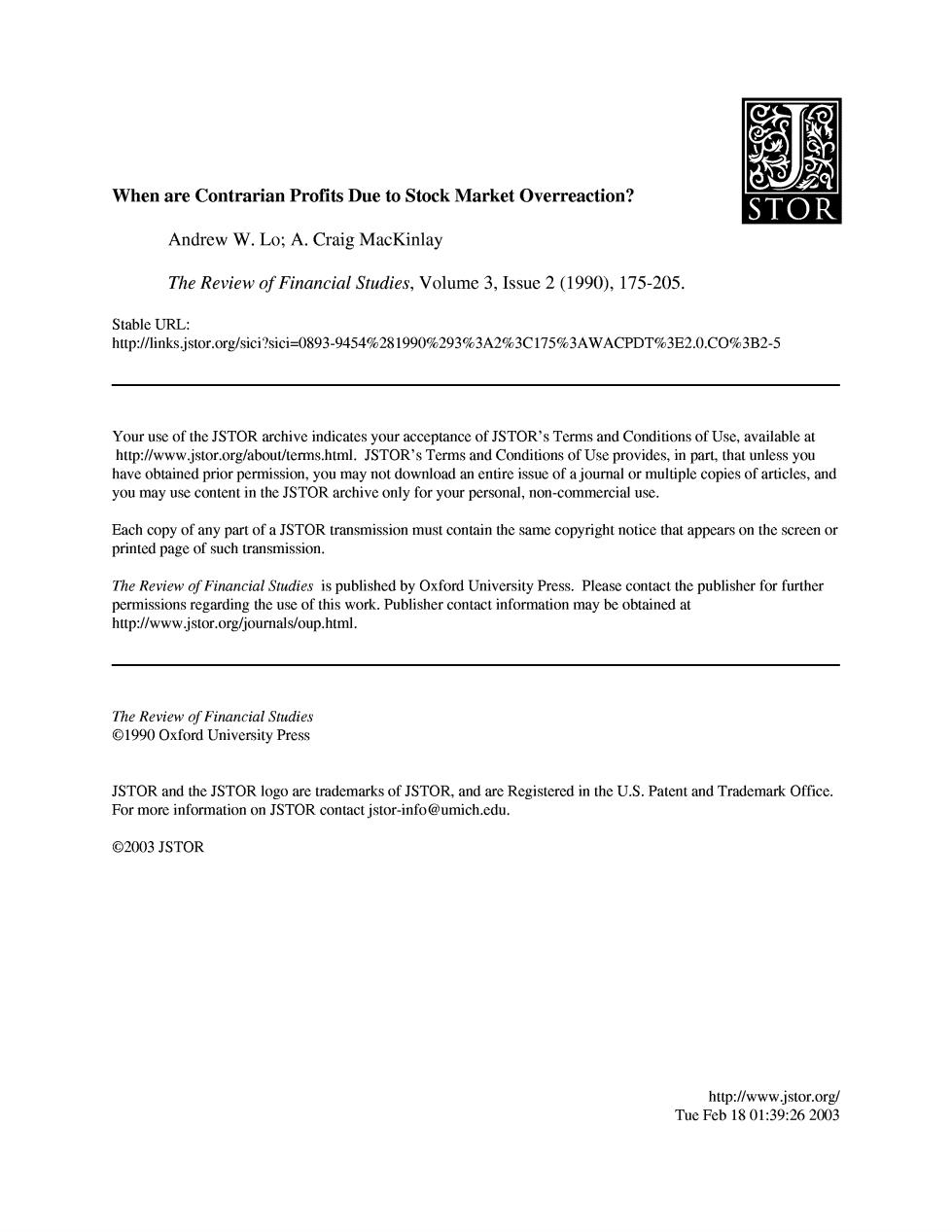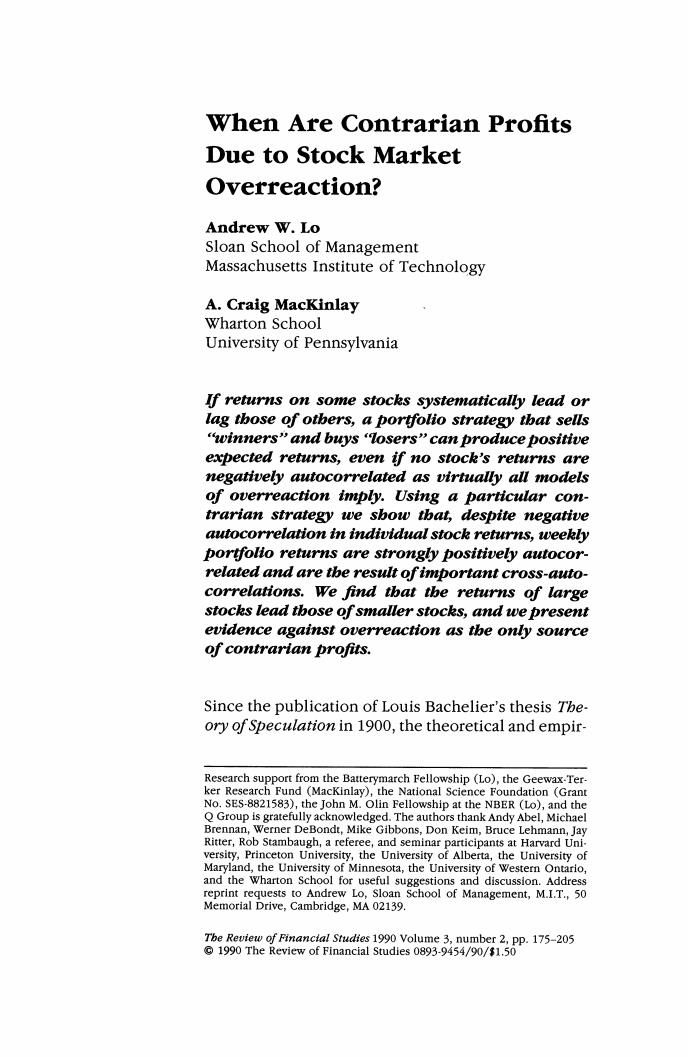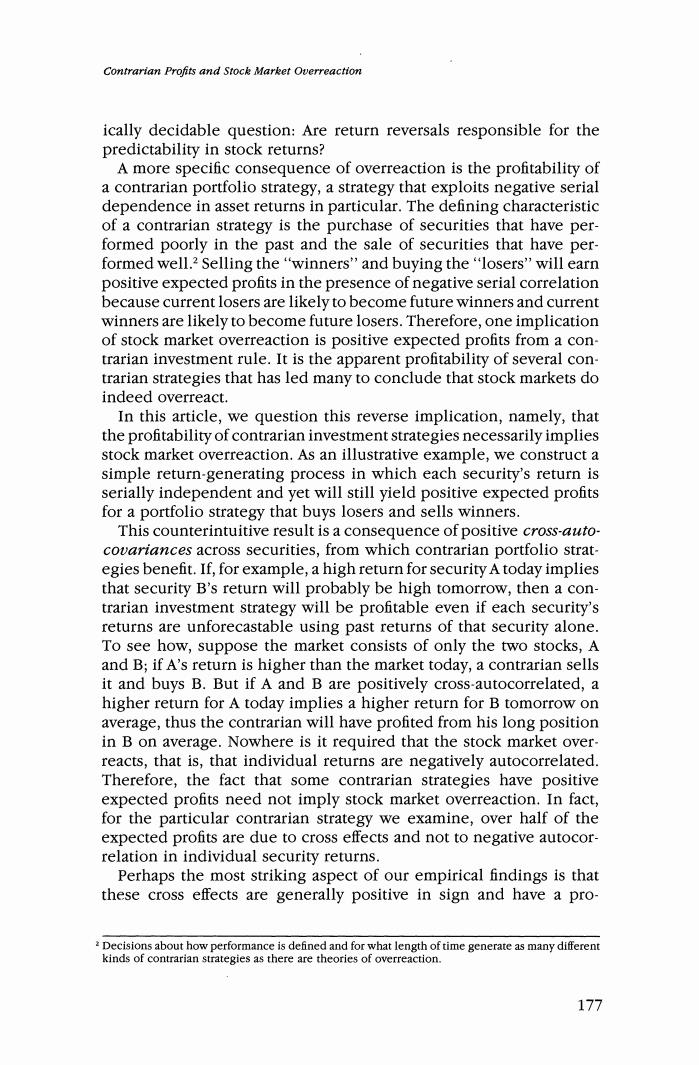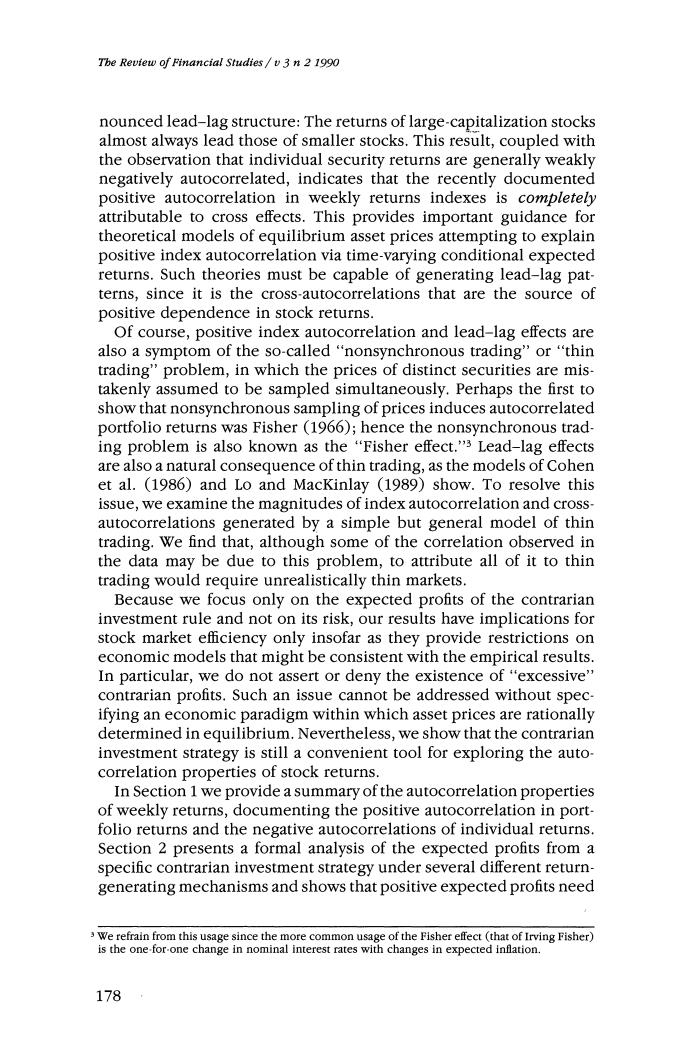
When are Contrarian Profits Due to Stock Market Overreaction? T● Andrew W.Lo;A.Craig MacKinlay The Review of Financial Studies,Volume 3,Issue 2 (1990).175-205. Stable URL: http://links.jstor.org/sici?sici=0893-9454%281990%293%3A2%3C175%3AWACPDT%3E2.0.CO%3B2-5 Your use of the JSTOR archive indicates your acceptance of JSTOR's Terms and Conditions of Use,available at http://www.jstor.org/about/terms.html.JSTOR's Terms and Conditions of Use provides,in part,that unless you have obtained prior permission,you may not download an entire issue of a journal or multiple copies of articles,and you may use content in the JSTOR archive only for your personal,non-commercial use. Each copy of any part of a JSTOR transmission must contain the same copyright notice that appears on the screen or printed page of such transmission. The Review of Financial Studies is published by Oxford University Press.Please contact the publisher for further permissions regarding the use of this work.Publisher contact information may be obtained at http://www.jstor.org/journals/oup.html. The Review of Financial Studies 1990 Oxford University Press JSTOR and the JSTOR logo are trademarks of JSTOR,and are Registered in the U.S.Patent and Trademark Office. For more information on JSTOR contact jstor-info@umich.edu. ©2003 JSTOR http://www.jstor.org/ Tue Feb1801:39:262003

When Are Contrarian Profits Due to Stock Market Overreaction? Andrew W.Lo Sloan School of Management Massachusetts Institute of Technology A.Craig MacKinlay Wharton School University of Pennsylvania If returns on some stocks systematically lead or lag those of otbers,a portfolio strategy that sells c“vinners”and buys "losers”can produce positive expected returns,even if no stock's returns are negatively autocorrelated as virtually all models of overreaction imply.Using a particular con- trarian strategy we sbow tbat,despite negative autocorrelation in individual stock returns,weekly portfolio returns are strongly positively autocor- related and are tbe result ofimportant cross-auto- correlations.We find that the returns of large stocks lead those of smaller stocks,and we present evidence against overreaction as the only source of contrarian profits. Since the publication of Louis Bachelier's thesis The- ory ofSpeculation in 1900,the theoretical and empir- Research support from the Batterymarch Fellowship (Lo),the Geewax.Ter- ker Research Fund (MacKinlay),the National Science Foundation (Grant No.SES-8821583),the John M.Olin Fellowship at the NBER (Lo),and the Q Group is gratefully acknowledged.The authors thank Andy Abel,Michael Brennan,Werner DeBondt,Mike Gibbons,Don Keim,Bruce Lehmann,Jay Ritter,Rob Stambaugh,a referee,and seminar participants at Harvard Uni- versity,Princeton University,the University of Alberta,the University of Maryland,the University of Minnesota,the University of Western Ontario, and the Wharton School for useful suggestions and discussion.Address reprint requests to Andrew Lo,Sloan School of Management,M.I.T.,50 Memorial Drive,Cambridge,MA 02139. The Review of Financial Studies 1990 Volume 3,number 2,pp.175-205 1990 The Review of Financial Studies 0893-9454/90/$1.50

Tbe Review of Financial Studtes /v 3 n 2 1990 ical implications of the random walk hypothesis as a model for spec- ulative prices have been subjects of considerable interest to financial economists.First developed by Bachelier from rudimentary economic considerations of"fair games,"the random walk has received broader support from the many early empirical studies confirming the unpre- dictability of stock-price changes.1 Of course,as Leroy (1973)and Lucas (1978)have shown,the unforecastability of asset returns is neither a necessary nor a sufficient condition of economic equilib- rium.And,in view of the empirical evidence in Lo and MacKinlay (1988),it is also apparent that historical stock market prices do not follow random walks. This fact surprises many economists because the defining property of the random walk is the uncorrelatedness of its increments,and deviations from this hypothesis necessarily imply price changes that are forecastable to some degree.But our surprise must be tempered by the observation that forecasts of stock returns are still imperfect and may be subject to considerable forecast errors,so that "excess"' profit opportunities and market inefficiencies are not necessarily con- sequences of forecastability.Nevertheless,several recent studies maintain the possibility of significant profits and market inefficiencies, even after controlling for risk in one way or another. Some of these studies have attributed this forecastability to what has come to be known as the"stock market overreaction"'hypothesis, the notion that investors are subject to waves of optimism and pes- simism and therefore create a kind of"momentum"'that causes prices to temporarily swing away from their fundamental values [see,e.g., DeBondt and Thaler (1985,1987),DeLong,Shleifer,Summers,and Waldmann (1989),Lehmann (1988),Poterba and Summers (1988), and Shefrin and Statman(1985)].Although such a hypothesis does imply predictability,since what goes down must come up and vice versa,a well-articulated equilibrium theory of overreaction with sharp empirical implications has yet to be developed. But common to virtually all existing theories of overreaction is one very specific empirical implication:Price changes must be negatively autocorrelated for some holding period.For example,DeBondt and Thaler (1985)write:"If stock prices systematically overshoot,then their reversal should be predictable from past return data alone." Therefore,the extent to which the data are consistent with stock market overreaction,broadly defined,may be distilled into an empir- See,for example,the papers in Cootner (1964),and Fama (1965,1970).Our usage of the term "random walk"differs slightly from the classical definition of a process with independently and identically distributed increments.Since historically the property of primary economic interest has been the uncorrelatedness of increments,we also consider processes with uncorrelated but het- erogeneously distributed dependent increments to be random walks. 176

Contrarian Profits and Stock Market Overreaction ically decidable question:Are return reversals responsible for the predictability in stock returns? A more specific consequence of overreaction is the profitability of a contrarian portfolio strategy,a strategy that exploits negative serial dependence in asset returns in particular.The defining characteristic of a contrarian strategy is the purchase of securities that have per- formed poorly in the past and the sale of securities that have per- formed well.2 Selling the"winners"and buying the"losers"will earn positive expected profits in the presence of negative serial correlation because current losers are likely to become future winners and current winners are likely to become future losers.Therefore,one implication of stock market overreaction is positive expected profits from a con. trarian investment rule.It is the apparent profitability of several con- trarian strategies that has led many to conclude that stock markets do indeed overreact. In this article,we question this reverse implication,namely,that the profitability of contrarian investment strategies necessarily implies stock market overreaction.As an illustrative example,we construct a simple return-generating process in which each security's return is serially independent and yet will still yield positive expected profits for a portfolio strategy that buys losers and sells winners. This counterintuitive result is a consequence of positive cross-auto- covariances across securities,from which contrarian portfolio strat- egies benefit.If,for example,a high return for security A today implies that security B's return will probably be high tomorrow,then a con- trarian investment strategy will be profitable even if each security's returns are unforecastable using past returns of that security alone. To see how,suppose the market consists of only the two stocks,A and B;if A's return is higher than the market today,a contrarian sells it and buys B.But if A and B are positively cross-autocorrelated,a higher return for A today implies a higher return for B tomorrow on average,thus the contrarian will have profited from his long position in B on average.Nowhere is it required that the stock market over- reacts,that is,that individual returns are negatively autocorrelated. Therefore,the fact that some contrarian strategies have positive expected profits need not imply stock market overreaction.In fact, for the particular contrarian strategy we examine,over half of the expected profits are due to cross effects and not to negative autocor- relation in individual security returns. Perhaps the most striking aspect of our empirical findings is that these cross effects are generally positive in sign and have a pro- Decisions about how performance is defined and for what length of time generate as many different kinds of contrarian strategies as there are theories of overreaction. 177

The Revfew of Financial Studies /v 3 n 2 1990 nounced lead-lag structure:The returns of large-capitalization stocks almost always lead those of smaller stocks.This result,coupled with the observation that individual security returns are generally weakly negatively autocorrelated,indicates that the recently documented positive autocorrelation in weekly returns indexes is completely attributable to cross effects.This provides important guidance for theoretical models of equilibrium asset prices attempting to explain positive index autocorrelation via time-varying conditional expected returns.Such theories must be capable of generating lead-lag pat- terns,since it is the cross-autocorrelations that are the source of positive dependence in stock returns. Of course,positive index autocorrelation and lead-lag effects are also a symptom of the so-called "nonsynchronous trading"or "thin trading"problem,in which the prices of distinct securities are mis- takenly assumed to be sampled simultaneously.Perhaps the first to show that nonsynchronous sampling of prices induces autocorrelated portfolio returns was Fisher (1966);hence the nonsynchronous trad- ing problem is also known as the "Fisher effect."3 Lead-lag effects are also a natural consequence of thin trading,as the models of Cohen et al.(1986)and Lo and MacKinlay (1989)show.To resolve this issue,we examine the magnitudes of index autocorrelation and cross- autocorrelations generated by a simple but general model of thin trading.We find that,although some of the correlation observed in the data may be due to this problem,to attribute all of it to thin trading would require unrealistically thin markets. Because we focus only on the expected profits of the contrarian investment rule and not on its risk,our results have implications for stock market efficiency only insofar as they provide restrictions on economic models that might be consistent with the empirical results. In particular,we do not assert or deny the existence of "excessive" contrarian profits.Such an issue cannot be addressed without spec- ifying an economic paradigm within which asset prices are rationally determined in equilibrium.Nevertheless,we show that the contrarian investment strategy is still a convenient tool for exploring the auto- correlation properties of stock returns. In Section 1 we provide a summary of the autocorrelation properties of weekly returns,documenting the positive autocorrelation in port- folio returns and the negative autocorrelations of individual returns. Section 2 presents a formal analysis of the expected profits from a specific contrarian investment strategy under several different return- generating mechanisms and shows that positive expected profits need We refrain from this usage since the more common usage of the Fisher effect(that of Irving Fisher) is the one-for-one change in nominal interest rates with changes in expected inflation. 178